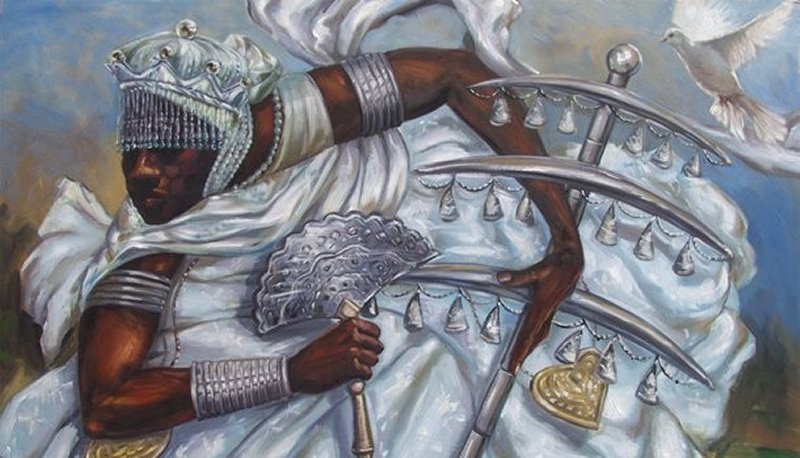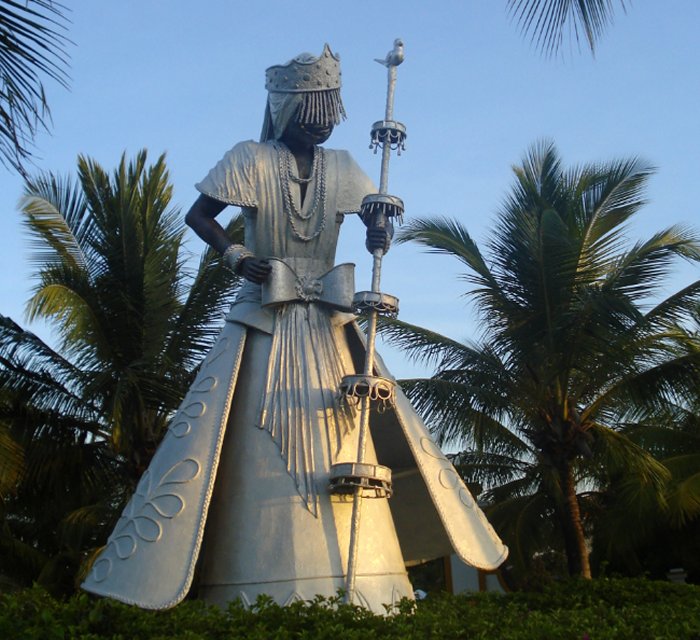A. Sutherland – AncientPages.com – The Yoruba say that the planet Earth was nothing but an enormous expanse of water and marshes in the beginning. Yoruba people have several accounts of the creation story; in some, Obatala created land, humans, and vegetation.
 Obatala, the great god of creation in Yoruba people’s beliefs. source
Obatala, the great god of creation in Yoruba people’s beliefs. source
He is the divine creator and Lord of heaven, Earth, and men by the supreme god Olorun (or Olodumare – “Owner of Endless Space”).
Greatness Of Obatala God In Yoruba Religion
Obatala is believed to be the Sky Father who created humans and brought them to life by the divine breath of Olorun. The name ‘Obatala’ is interesting.
Obatala (full name: ObaTi o Ni Ala) is the oldest and most potent divinity in the Yoruba religion.
Oba means ‘King,’ ‘Lord,’ or Leader. It can also mean master.
Ti O Ni – means ‘that has,’ and Ala means whiteness (or boundaries, vision, or even dream)
The Yoruba’s great god is called by many names, including the Lord of whiteness, the master of purity, the king of vision, the leader of dreams, the deity of hope, the Lord of divinities, and the divinity of surreal.
As the second in command in the Yoruba pantheon, Obatala is also the father of all Orishas (orisas), the spirits sent by Olodumare from heaven to Àiyé (Earth) to guard all creation and humanity in particular, and show how to live and be successful and happy on Earth.
Legends say most Orishas are said to have previously existed in the spirit world. In Yoruba’s native religion, Obatala is a symbol of human consciousness; his color is white, and his followers consider themselves his “children” and dress in white and wear white necklaces.
Creation Of Land Upon The Water
As Olorun’s representative on Earth, Obatala was authorized to create land upon the water beneath the sky. Due to his efforts, the first Yoruba city, Ife, was founded. Still, before it happened, Obatala suggested to the great Olorun that Earth would be significantly improved if there were solid land on this planet on which Orishas and other forms of life could live.
 Obatala, god of creation (especially humans) and the sky in the religion of Yoruba people. source
Obatala, god of creation (especially humans) and the sky in the religion of Yoruba people. source
Olorun – ᴀssociated with peace, harmony, justice, and purity – agreed, and now, Obatala theoretically could begin to realize his task, but he needed to figure out how and where to start. He went to the god of divination, Orunmila, who could divine the best way to proceed with any undertaking.
When instructions were ready and clear, Obatala descended to Earth on a golden chain and poured sand on the waters, but the land was not ready yet, so at first, he placed a hen and a pigeon on the sand, according to the instructions given to him.
The birds scratched at the sand, scattering it in all directions. Where the sand fell, the waters turned into dry land. From now on, Obatala stepped down onto the ground to play his role as a representative on Earth. He started with the foundation of the first Yoruba city – Ife.
It should be added that the oral traditions of the Yoruba people say that Ife was where civilization and its life began. People still continue to produce the Ife heads that are regarded as the seat of the divine power of the Supreme Being.
Many more palm trees emerged from one palm tree he planted, and the Supreme Being, Olorun, sent his servant, the chameleon Agemo, to Earth to ask how Obatala was doing. Obatala was quite satisfied with his creation but wanted to improve it with more light on the planet, so Olorun created the Sun.
Creation Of Humans Out Of Clay
After some time, Obatala decided that things on Earth needed further improvements. He shaped human figures out of clay and called on Olorun to breathe life into them. However, while Obatala was forming the humans, he had become thirsty and had drunk too much palm wine. In some versions of the story, the trickster Eshu was said to have tempted the creator with the wine. Obatala’s drunkenness caused him to create many humans with severe deformities. Filled with great remorse, the creator promised to be the special protector of all humans with disabilities.
Obatala gave people the tools they needed for life, and humanity flourished and grew. He ruled Ife for many years. Eventually, he became homesick, ascended the golden chain, and returned to the sky.
The “creation of life from clay” stories can be found in mythology, literature, and modern theory. The ram-headed god Khnum (“The Great Potter,” also known as “The Guardian of the Cataract”) was one of the earliest Egyptian deities who created humankind from clay. Ancient Greek beliefs confirm that Prometheus shaped man out of mud, and Athena breathed life into his clay figure. In “Tablets of Sumer,” Samuel Noah Kramer wrote that Nammu and Ninhursag, accompanied by deities – the ‘good and princely fashioners’ – mixed clay, which was ‘over the abyss’ and brought man into existence.
“Eridu Genesis,” a Sumerian epic, is mainly devoted to creating world-building cities, and the flood event tells that the deities fashioned humans from clay to cultivate the soil, care for cattle, and continue the worship of their gods. Also, according to Hindu mythology, the mother of Ganesha Parvati made the boy from clay and turned the clay into flesh and blood.
According to Inca beliefs, the creator god Viracocha formed humans from clay on his second attempt at creating living creatures. On the other hand, the Maori people believe that Tane Mahuta, the god of the forest, formed the first woman out of clay and breathed life into her.
Written by – A. Sutherland – AncientPages.com Senior Staff Writer
Updated on Oct 10, 2023
Copyright © AncientPages.com All rights reserved. This material may not be published, broadcast, rewritten or redistributed in whole or part without the express written permission of AncientPages.com
Expand for references
References:
Olayinka Adewuyi, Obatala: The Greatest and Oldest Divinity
Baba I. Karade, The Handbook of Yoruba Religious Concepts
Wikipedia





